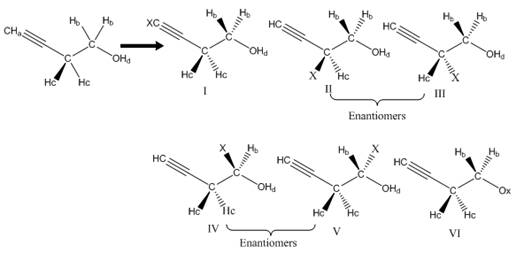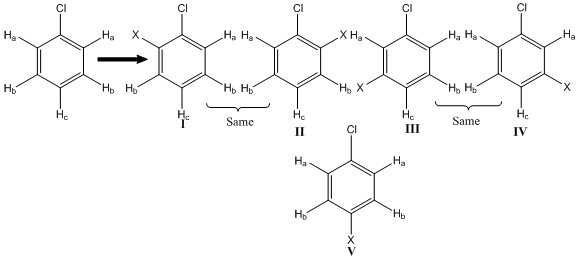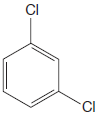
Concept explainers
(a)
Interpretation:
How many chemically distinct H atoms are in the given molecule is to be determined.
Concept introduction:
Sometimes, it is not immediately obvious whether certain hydrogen atoms in a molecule are chemically distinct. In such cases, the chemical distinction test is used. Chemical distinction test is a test in which the complete structure of the molecule is to be drawn in which and only the hydrogen atom is replaced by an imaginary “X” atom. There should be one X-substituted molecule for each hydrogen atom being tested. If the chemical distinction test yields enantiomers, then the corresponding hydrogen atoms are said to be enantiotopic. If the test yields diastereomers, then the corresponding hydrogen atoms are said to be diastereotopic.
Answer to Problem 16.8P
There are two types of chemically distinct H atoms in the given molecule.
Explanation of Solution
The given molecule is:

There are five H atoms in the above compound. These H atoms are not easily identified whether they are distinct or similar. Thus, the chemical distinction test is used here.
All H atoms in the compound are replaced by “X”; all possible structures are as shown below:

Molecules I and II are enantiomers i.e. mirror images of each other. According to chemical distinction test, these H atoms are not chemically distinct. Molecules I/II and III are constitutional isomers, these H atoms are chemically distinct. Therefore, there are two distinct types of protons, one for CHa protons and one for the methyl CH3 protons in the given molecule a.
Number of chemically distinct H atoms in the given molecule is determined using a chemical distinction test.
(b)
Interpretation:
How many chemically distinct H atoms are in the given molecule is to be determined.
Concept introduction:
Sometimes, it is not immediately obvious whether certain hydrogen atoms in a molecule are chemically distinct. In such cases the chemical distinction test is used. Chemical distinction test is a test in which the complete structure of the molecule is to be drawn in which and only the hydrogen atom is replaced by an imaginary “X” atom. There should be one X-substituted molecule for each hydrogen atom being tested. If the chemical distinction test yields enantiomers, then the corresponding hydrogen atoms are said to be enantiotopic. If the test yields diastereomers, then the corresponding hydrogen atoms are said to be diastereotopic.
Answer to Problem 16.8P
There are four types of chemically distinct H atoms in the given molecule.
Explanation of Solution
The given molecule is:

There are six H atoms in the above compound. These H atoms are not easily identified as distinct or similar. Thus, the chemical distinction test is used here.
All H atoms in the compound are replaced by “X”; all possible structures are as shown below:

Molecules I, II/III, IV/V, and VI are constitutional isomers. According to chemical distinction test, these H atoms are chemically distinct. Molecules II and III also IV and V are enantiomers; these H atoms are not chemically distinct according to the test. Thus, there are total four types of chemically distinct protons in the given molecule b.
Number of chemically distinct H atoms in the given molecule are determined using chemical distinction test.
(c)
Interpretation:
How many chemically distinct H atoms are in the given molecule is to be determined.
Concept introduction:
Sometimes, it is not immediately obvious whether certain hydrogen atoms in a molecule are chemically distinct. In such cases the chemical distinction test is used. Chemical distinction test is a test in which the complete structure of the molecule is to be drawn in which and only the hydrogen atom is replaced by an imaginary “X” atom. There should be one X-substituted molecule for each hydrogen atom being tested. If the chemical distinction test yields enantiomers, then the corresponding hydrogen atoms are said to be enantiotopic. If the test yields diastereomers, then the corresponding hydrogen atoms are said to be diastereotopic.
Answer to Problem 16.8P
There are three types of chemically distinct H atoms in the given molecule.
Explanation of Solution
The given molecule is:

There are five H atoms in the above compound. These H atoms are not easily identified as distinct or similar. Thus, the chemical distinction test is used here.
All H atoms in the compound are replaced by “X”; all possible structures are as shown below:

Molecules I and II, and also III and IV are the same molecules. Molecules I/II, III/IV, and V are consititutional isomers. These H atoms are distinct according to the chemical distinction test. Therefore, there are three types of chemically distinct H atoms in the given molecule c.
Number of chemically distinct H atoms in the given molecul, are determined using chemical distinction test.
(d)
Interpretation:
How many chemically distinct H atoms are in the given molecule is to be determined.
Concept introduction:
Sometimes, it is not immediately obvious whether certain hydrogen atoms in a molecule are chemically distinct. In such cases the chemical distinction test is used. Chemical distinction test is a test in which the complete structure of the molecule is to be drawn in which and only the hydrogen atom is replaced by an imaginary “X” atom. There should be one X-substituted molecule for each hydrogen atom being tested. If the chemical distinction test yields enantiomers, then the corresponding hydrogen atoms are said to be enantiotopic. If the test yields diastereomers, then the corresponding hydrogen atoms are said to be diastereotopic.
Answer to Problem 16.8P
There are three types of chemically distinct H atoms in the given molecule.
Explanation of Solution
The given molecule is:

There are four H atoms in the above compound. These H atoms are not easily identified s distinct or similar. Thus, the chemical distinction test is used here.
All H atoms in compound are replaced by “X”; all possible structures are as shown below:

Molecules II and III are the same molecule. Molecules I, II/III and IV are constitutional isomers. According to the chemical distinction test, these H atoms are distinct. Therefore, there are three types of chemically distinct H atoms in the given molecule d.
Number of chemically distinct H atoms in the given molecule is determined using the chemical distinction test.
(e)
Interpretation:
How many chemically distinct H atoms are in the given molecule is to be determined.
Concept introduction:
Sometimes, it is not immediately obvious whether certain hydrogen atoms in a molecule are chemically distinct. In such cases the chemical distinction test is used. Chemical distinction test is a test in which the complete structure of the molecule is to be drawn in which and only the hydrogen atom is replaced by an imaginary “X” atom. There should be one X-substituted molecule for each hydrogen atom being tested. If the chemical distinction test yields enantiomers, then the corresponding hydrogen atoms are said to be enantiotopic. If the test yields diastereomers, then the corresponding hydrogen atoms are said to be diastereotopic.
Answer to Problem 16.8P
There is one type of chemically distinct H atom in the given molecule.
Explanation of Solution
The given molecule is:

There are four H atoms in the above compound. These H atoms are not easily identified as distinct or similar. Thus, the chemical distinction test is used here.
All H atoms in compound are replaced by “X”; all possible structures are as shown below:

All molecules, I, II, III and IV are same. These H atoms are not distinct according to the chemical distinction test. Therefore, there is only one type of chemically distinct H atoms in the given molecule e.
Number of chemically distinct H atoms in the given molecule is determined using chemical distinction test.
(f)
Interpretation:
How many chemically distinct H atoms are in the given molecule is to be determined.
Concept introduction:
Sometimes, it is not immediately obvious whether certain hydrogen atoms in a molecule are chemically distinct. In such cases the chemical distinction test is used. Chemical distinction test is a test in which the complete structure of the molecule is to be drawn in which and only the hydrogen atom is replaced by an imaginary “X” atom. There should be one X-substituted molecule for each hydrogen atom being tested. If the chemical distinction test yields enantiomers, then the corresponding hydrogen atoms are said to be enantiotopic. If the test yields diastereomers, then the corresponding hydrogen atoms are said to be diastereotopic.
Answer to Problem 16.8P
There are three types of chemically distinct H atoms in the given molecule.
Explanation of Solution
The given molecule is:

There are five H atoms in the above compound. These H atoms are not easily identified as distinct or similar. Thus, the chemical distinction test is used here.
All H atoms in compound are replaced by “X”; all possible structures are as shown below:

Molecules I and II, and also III and IV are the same molecule. Molecules I/II and III/IV are constitutional isomers. According to the chemical distinction test, these H atoms are chemically distinct. Therefore, there are three types of chemically distinct H atoms, two from the
Number of chemically distinct H atoms in the given molecule is determined using chemical distinction test.
Want to see more full solutions like this?
Chapter 16 Solutions
ORGANIC CHEM PRINC & MECH (BUNDLE)
- DATA: Standard Concentration (caffeine) mg/L Absorbance Reading 10 0.322 20 0.697 40 1.535 60 2.520 80 3.100arrow_forwardIn what position will p-Toluidine be nitrated and what will the compound be called.arrow_forwardIn what position will 4-methylbenzonitrile be nitrated and what will the compound be called.arrow_forward
- In what position will benzenesulfonic acid be nitrated?arrow_forwardIf compound A reacts with an excess of methyl iodide and then heated with aqueous Ag₂O, indicate only the major products obtained. Draw their formulas. A Harrow_forwardExplanation Check 1:01AM Done 110 Functional Groups Identifying and drawing hemiacetals and acetals In the drawing area below, create a hemiacetal with 1 ethoxy group, 1 propoxy group, and a total of 9 carbon atoms. Click and drag to start drawing a structure. ✓ $ 2025 McGraw Hill LLC. All Rights Reserved. Terms of Use Sarrow_forward
- Write the systematic name of each organic molecule: CI structure CI CI Explanation CI ठ CI Check B ☐ 188 F1 80 name F2 F3 F4 F5 F6 60 F7 2arrow_forwardWrite the systematic name of each organic molecule: structure i HO OH Explanation Check name ☐ ☐arrow_forwardX 5 Check the box under each molecule that has a total of five ẞ hydrogens. If none of the molecules fit this description, check the box underneath the table. CI Br Br Br 0 None of these molecules have a total of five ẞ hydrogens. Explanation Check esc F1 F2 tab caps lock fn Q @2 A W # 3 OH O OH HO © 2025 McGraw Hill LLC. All Rights Reserved. Terms of Use | Privacy Center | Accessibility IK F7 F7 F8 TA F9 F10 & 6 28 * ( > 7 8 9 0 80 F3 O F4 KKO F5 F6 S 64 $ D % 25 R T Y U பட F G H O J K L Z X C V B N M H control option command P H F11 F12 + || { [ command optionarrow_forward
- An open vessel containing water stands in a laboratory measuring 5.0 m x 5.0 m x 3.0 m at 25 °C ; the vapor pressure (vp) of water at this temperature is 3.2 kPa. When the system has come to equilibrium, what mass of water will be found in the air if there is no ventilation? Repeat the calculation for open vessels containing benzene (vp = 13.1 kPa) and mercury (vp = 0.23 Pa)arrow_forwardEvery chemist knows to ‘add acid to water with constant stirring’ when diluting a concentrated acid in order to keep the solution from spewing boiling acid all over the place. Explain how this one fact is enough to prove that strong acids and water do not form ideal solutions.arrow_forwardThe predominant components of our atmosphere are N₂, O₂, and Ar in the following mole fractions: χN2 = 0.780, χO2 = 0.21, χAr = 0.01. Assuming that these molecules act as ideal gases, calculate ΔGmix, ΔSmix, and ΔHmix when the total pressure is 1 bar and the temperature is 300 K.arrow_forward
 Organic Chemistry: A Guided InquiryChemistryISBN:9780618974122Author:Andrei StraumanisPublisher:Cengage Learning
Organic Chemistry: A Guided InquiryChemistryISBN:9780618974122Author:Andrei StraumanisPublisher:Cengage Learning

